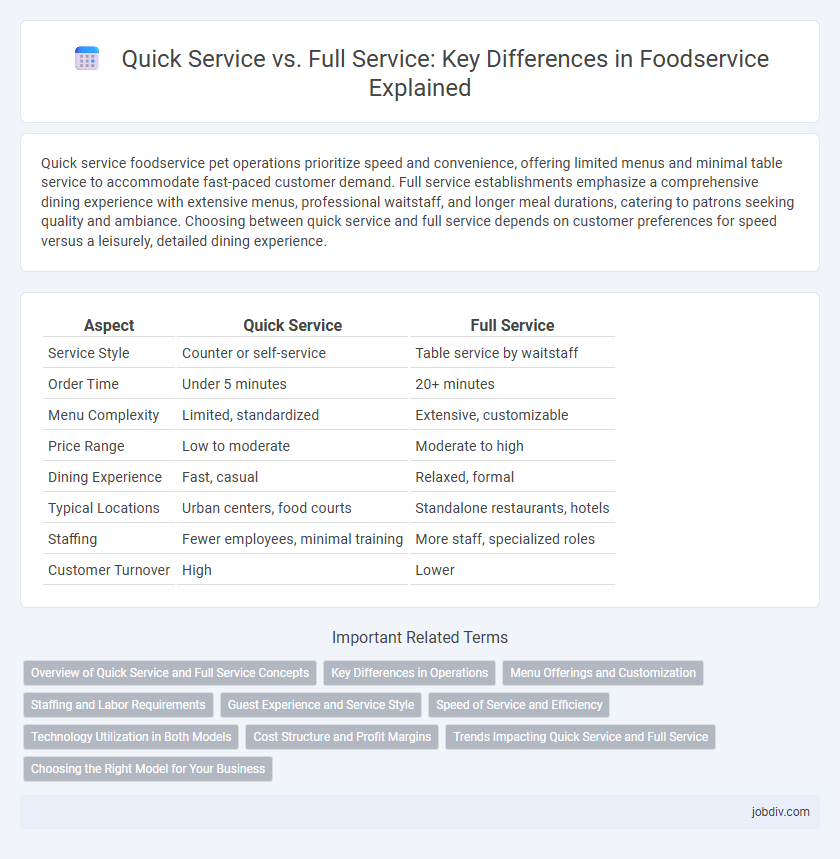Quick service foodservice pet operations prioritize speed and convenience, offering limited menus and minimal table service to accommodate fast-paced customer demand. Full service establishments emphasize a comprehensive dining experience with extensive menus, professional waitstaff, and longer meal durations, catering to patrons seeking quality and ambiance. Choosing between quick service and full service depends on customer preferences for speed versus a leisurely, detailed dining experience.
Table of Comparison
| Aspect | Quick Service | Full Service |
|---|---|---|
| Service Style | Counter or self-service | Table service by waitstaff |
| Order Time | Under 5 minutes | 20+ minutes |
| Menu Complexity | Limited, standardized | Extensive, customizable |
| Price Range | Low to moderate | Moderate to high |
| Dining Experience | Fast, casual | Relaxed, formal |
| Typical Locations | Urban centers, food courts | Standalone restaurants, hotels |
| Staffing | Fewer employees, minimal training | More staff, specialized roles |
| Customer Turnover | High | Lower |
Overview of Quick Service and Full Service Concepts
Quick service restaurants (QSRs) prioritize speed, convenience, and affordability, offering limited menus and counter service to accommodate high customer turnover. Full service restaurants deliver a comprehensive dining experience with table service, diverse menu options, and an emphasis on ambiance and customer interaction. Both concepts cater to different customer needs, with QSRs focusing on efficiency and Full Service establishments emphasizing comfort and extended dining.
Key Differences in Operations
Quick service restaurants prioritize speed and efficiency, offering limited menus with standardized food preparation to serve customers rapidly. Full service establishments emphasize customer experience through diverse menus, table service, and longer dining times, requiring more staff and complex operational management. Operational differences include order-taking methods, kitchen workflows, and customer interaction levels, influencing staffing, training, and overall service models.
Menu Offerings and Customization
Quick service restaurants (QSRs) emphasize streamlined menu offerings with limited customization to ensure fast preparation and turnover, often featuring standardized items like burgers, sandwiches, and salads. Full service restaurants provide extensive menu options with greater customization, allowing guests to modify dishes according to dietary preferences and ingredient choices. This flexibility in full service settings supports a personalized dining experience, catering to diverse tastes and nutritional needs.
Staffing and Labor Requirements
Quick service restaurants require fewer staff with multitasking skills to handle high customer turnover efficiently, emphasizing speed and operational simplicity. Full service establishments demand a larger, specialized team including servers, hosts, and kitchen staff to provide comprehensive dining experiences and personalized customer service. Labor costs are generally higher in full service settings due to increased staff numbers and the need for trained personnel to manage complex food preparation and customer interactions.
Guest Experience and Service Style
Quick Service restaurants prioritize speed and convenience, offering streamlined menus and minimal table service to cater to fast-paced guest preferences. Full Service establishments emphasize a more personalized guest experience with attentive staff, comprehensive menus, and a relaxed dining atmosphere encouraging longer visits. Both service styles shape customer expectations and satisfaction by balancing efficiency and engagement tailored to distinct dining occasions.
Speed of Service and Efficiency
Quick service restaurants (QSRs) prioritize speed of service by streamlining menu options, utilizing automated ordering systems, and optimizing kitchen workflows to serve customers within minutes. Full service restaurants emphasize a slower, more personalized dining experience, often resulting in longer wait times but higher service quality and customer satisfaction. Efficiency in QSRs is driven by volume and rapid turnover, while full service efficiency balances staff attentiveness with table turnover.
Technology Utilization in Both Models
Quick Service Restaurants (QSRs) leverage technology through automated ordering kiosks, mobile apps, and rapid payment systems to enhance speed and efficiency, catering to high customer turnover. Full Service Restaurants (FSRs) integrate technology for reservation management, digital menu displays, and advanced POS systems aimed at improving customer experience and operational precision. Both models utilize data analytics to optimize inventory, personalize marketing, and streamline staff allocation but differ significantly in technology focus reflecting their service delivery priorities.
Cost Structure and Profit Margins
Quick service restaurants (QSRs) typically maintain lower cost structures due to reduced labor expenses and streamlined menus, resulting in tighter profit margins but higher sales volume. Full service restaurants incur higher fixed and variable costs from extensive staffing, ambiance, and ingredient quality, which can lead to more substantial profit margins per transaction despite lower turnover rates. Efficient inventory management and menu engineering are critical for both models to optimize profitability within their respective cost frameworks.
Trends Impacting Quick Service and Full Service
Rapid innovation in technology and evolving consumer preferences are driving the growth of quick service restaurants (QSRs) through mobile ordering, contactless payment, and delivery apps. Full service restaurants (FSRs) are adapting by enhancing in-dining experiences with personalized service and menu customization to maintain customer loyalty amid rising competition. Sustainability and health-conscious trends increasingly influence both sectors, pushing QSRs to offer healthier options and FSRs to source local and organic ingredients.
Choosing the Right Model for Your Business
Quick Service Restaurants (QSR) prioritize speed, affordability, and convenience, attracting customers seeking fast meals with minimal wait times. Full Service Restaurants (FSR) emphasize a comprehensive dining experience with table service, higher quality meals, and a comfortable ambiance, catering to guests valuing atmosphere and personalized attention. Selecting the appropriate model depends on factors such as target market preferences, operational costs, location, and desired brand positioning to optimize profitability and customer satisfaction.
Quick Service vs Full Service Infographic

 jobdiv.com
jobdiv.com